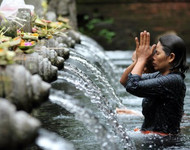The Practice Of Daily Rituals
Posted by Dr. Hazel Alexander
Rituals can be simple or complex, and every religion uses them in some form or another. Yet mentioning the word ‘ritual’ to many people causes them to instantly become wary, nervous or suspicious in some way. Many people feel that ritual equates with complex ceremonies, the wearing of robes, and the chanting of difficult verses that they must learn by heart, so the whole idea feels off-putting or intimidating or even boring.
(Photo is of Ritual Bathing at Puru Tirtha Empul, Bali)
However, the daily practice of personal rituals is a very individualistic thing, and so can be as plain, creative, peaceful, or stimulating, as you feel is necessary or beneficial for their intended purpose.
Whatever your faith, background or circumstances, you’ll be able to practice a personal daily ritual, and in doing so you’ll begin to feel the benefits to yourself and your life after less than a week. The main purpose of daily ritual as one of the methods of assisting your spiritual growth, is to use it to develop your connection with the Divine.
Daily rituals can also be used for many purposes, such a calming or invigorating yourself at the start, or end of the day. They can be used to raise your inner power, or to assist with healing, or to help you feel more positive about yourself. The list of uses is very long! The most important thing to be aware of is that the ritual is YOURS, and it’s between you and the Divine, so you need to develop something that possesses individual meaning for yourself, and that serves the purpose you want it to, always bearing in mind the sacred and special nature of the procedure.
Rituals can be all shapes and sizes, and can occur in most locations, with one or many people. Those who are experienced at leading rituals seemingly have no boundaries, but as a beginner it’s best to simply develop your practice first, and then you can get more adventurous as you gain confidence. Small steps. So we’ll start with the basics. First of all, you’ll need to create a private sacred space that will serve as your focal point. This will be your personal altar and it needn’t be extravagant. If you have little space, you could use a small shelf or small table, or a mantelpiece, or even a portable surface such as a pretty cloth that you can fold and store away after use.
In your altar surface (which you won’t use for any other purpose) you’ll need to place things that are evocative for

you, and will help to focus your mind, energy, and spirit, upon the process, mood, intention and aim of the ritual. A good starting point is to recall in what situation you feel closest to the Divine. Perhaps this is in nature, so try to recreate this atmosphere in your sacred space. Perhaps using a potted plant, or photos. Maybe you feel centred and focused by also using candles and incense. Maybe you’d like to place an icon, or statuette, or symbol of your faith, Master, or Deity, onto the altar.
Next you need to think about sound. Does music help you to connect with your spirituality? What kind? Perhaps you enjoy nature sounds, or the chime of prayer bells, or hymns, or complete silence? It’s important for you to think about all these things, and to experiment with them. Perhaps you’d feel more connected if you sat down in stillness, or jumped around, or danced, or sang, or chanted? Some days you may feel the need to use one method, then the next day another method. There are no hard and fast rules, as long as you hurt nor disturb no-one, including yourself.
Finally you need to think about what you aim to achieve. Apart from contacting the Divine, what further purpose do you wish your ritual to serve?
A few examples of daily Rituals
Here’s an example of a student’s morning ritual that holds individual meaning for her, and helps her to gain inner strength for the challenges of each new day. The Master she follows is Jesus, so she has a picture of him on her altar, with candles, flowers, a Celtic Cross, and a goblet holding fresh water. After she’s got dressed and ready for work, she stands in front of her altar in silent contemplation until she feels Christ with her. Then she recites the Lord’s Prayer. After this she sings part of the song ‘Morning Has Broken’, and recites a special prayer that she wrote herself, in which she asks Jesus to be with her through the day to give her strength and protection. Then she drinks the water in the goblet to end the ritual, which for her is an act of inner purification, and then finishes by pinching out the candles.
Another example comes from a student who feel a great connection with the moon goddesses, in particular Diana, so she practices her rituals at night, and uses them to either raise her inner power, to invigorate herself, or to chill out after a stressful day. Her altar is coloured in silver and blue, with candles, incense, water, symbols of the moon, and metal bells. Most of the time she uses music and dance in her rituals, together with verses that come from her heart on the spur of the moment.
Combining with Meditation can bring great contentment
When you combine the practice of daily ritual, with the practice of daily meditation and contemplation techniques, the rapidity of the positive transformation you will experience within yourself and your life is often completely stunning. There is often also a euphoric high of wellbeing, but this will settle down to a feeling of blissful contentment after a few weeks, and you’ll begin to be carried and motivated to follow your Path in greater depth and with greater commitment.
However it is often here that many students fall away, because they realise that developing true spiritual and wholistic completeness, and Oneness, isn’t an overnight ‘quick fix’ programme they can simply learn how to achieve by reading a book, or by attending a guru’s workshop. These things can only offer you sign-posts. The actual practice is up to you, and it is through your own personal spiritual experience and development that you will grow, and find your own answers, and feel connected, and fulfilled, and happy. However, your new awareness will cause you to see yourself and your life with a sharp clarity that many people find too uncomfortable or disturbing, and this also can make you turn back and return to your old ways, rather than allowing the transformation from caterpillar to butterfly to occur.
Your choice of faith Path is a very personal and individual thing
Certain aspects of your personal parth will be universal (i.e. applicable to all) and may share ethics and ideas in common with many people. However, the love in your heart and your spiritual insight and inner power have to be achieved and developed by your own efforts, whichever Path you choose to follow, because these things can’t simply be handed to you on a plate and have to be worked at through your own practice. Choose the Path you love and you’ll love the Path you choose. Your rituals, prayers, worship, and other spiritual practices will then be a great pleasure and a joy to you, and you’ll gain a great deal from them in many ways, so that spirituality will become the hub of your life and your strength, rather than it being an afterthought on the periphery of your weekly schedule. Allow your ritual practice to become a framework, like a handcrafted basket, in which you can safely explore and develop your spirituality, and enjoy it!
ENDS
© holisticshop and Hazel Alexander 2002. All rights reserved



